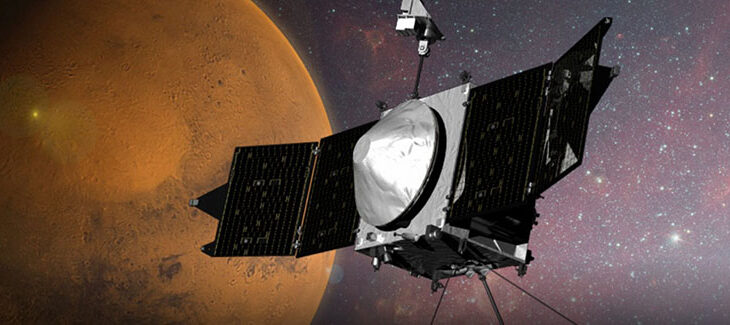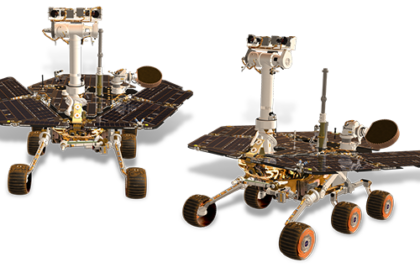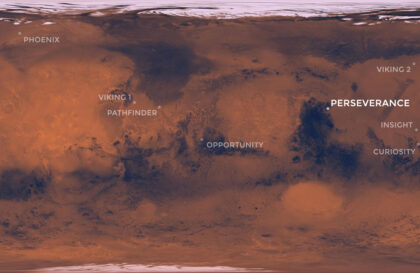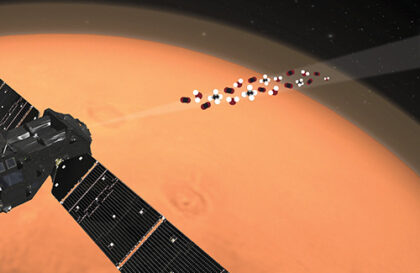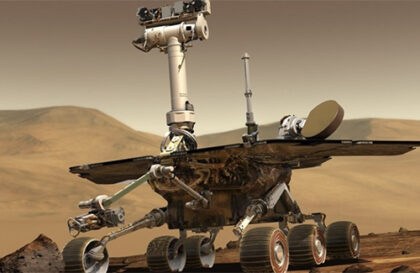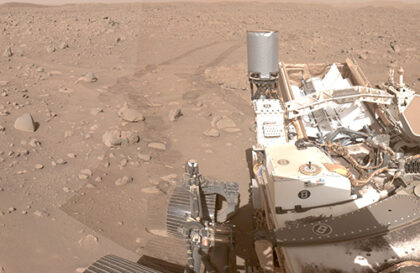September 21, 2023 marks nine years since MAVEN (Mars Atmosphere and Volatile EvolutioN) has been in Mars orbit.
MAVEN has indeed made many exciting discoveries during its time in space. Here are the 11 best:
- Atmospheric loss due to solar wind: MAVEN revealed that the solar wind played a central role in losing much of Mars’ atmosphere. As a result, the planet’s climate, once warm and humid, became cold and cool. This is how we see it now.
- Atmospheric loss rate: MAVEN determined the rate at which gas is being removed from the Martian atmosphere by the Sun and solar wind. Given the higher intensity of solar ultraviolet in the past, it can be assumed that significant gas volumes were lost from Mars over a long period.
- Isotopic measurements: MAVEN used isotope measurements to determine the gas volume lost during its time in space. Analysis of carbon isotopes of varying weights in the upper atmosphere revealed the amount of gas Mars lost over time. The results show that at least 2/3 of the gas was ejected into space.
- Seasonal changes in the atmosphere: MAVEN has detected seasonal and sun-dependent changes in ions and neutral particles in the upper atmosphere of Mars. Fluctuations occur ten times a year. Water decomposes into hydrogen and oxygen due to atmospheric influences when exposed to sunlight.
- Mars’ clumpy magnetic field: The solar wind and Mars interact more efficiently than expected. This is due to the lack of magnetic fields on Mars and the presence of a zone with magnetized crust, which can locally and regionally influence the encounter of their solar wind. As a result, the magnetic field formed due to this interaction quickly changes and becomes uneven or “lumpy.”
- Aurors on Mars: MAVEN has discovered widespread aurors in the Martian atmosphere. Auroras are caused by particles ejected by the Sun during solar storms. Once in the Martian atmosphere, these particles can speed up gas leakage into space by ten times.
Credits: NASA/LASP/CU Boulder
- New types of auroras: MAVEN has discovered two new types of auroras: “diffuse” and “proton.” These auroras differ from most terrestrial auroras because they are not associated with global or regional magnetic fields.
- Dust high above Mars: MAVEN detected dust up to 1,000 km above Mars’s surface, and metal ions in the Martian ionosphere formed due to the impact of interplanetary dust on the atmosphere. Although this layer is constantly present in the ionosphere, its activity increased significantly when Comet Siding Spring approached Mars in October 2014.
Credit: NASA
- Plasma waves: Plasma waves were detected using MAVEN, demonstrating the interaction of the solar wind with the Martian atmosphere. Surprisingly, solar wind particles can penetrate deep into the upper atmosphere of Mars instead of the expected circuit around the planet, thanks to the Martian ionosphere. This deep penetration becomes possible due to spontaneous effects in the ionosphere, transforming charged particles of solar energy into neutral atoms, which further penetrate into the depths.
Graphic illustrating the MAVEN spacecraft encountering plasma layers at Mars. Credit: Credits: NASA Goddard/CI lab
- External presence of methane: MAVEN confirmed the presence of methane in the Martian atmosphere.
- Interaction with Phobos: MAVEN investigated the interaction between Mars and its moon Phobos. Phobos falls to Mars and will be torn apart in about 40 million years. As a result, Mars will acquire rings, like the giant planets.
Banner image: NASA
Image credit:
https://mars.nasa.gov
https://www.nasa.gov
https://www.nasa.gov
https://mars.nasa.gov
